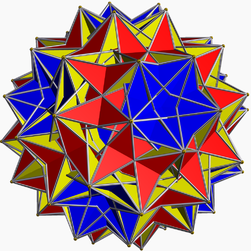- Great dirhombicosidodecahedron
-
Great dirhombicosidodecahedron 
Type Uniform star polyhedron Elements F = 124, E = 240
V = 60 (χ = −56)Faces by sides 40{3}+60{4}+24{5/2} Wythoff symbol |3/2 5/3 3 5/2 Symmetry group Ih, [5,3], *532 Index references U75, C92, W119 
4.5/3.4.3.4.
5/2.4.3/2
(Vertex figure)
Great dirhombicosidodecacron
(dual polyhedron)In geometry, the great dirhombicosidodecahedron is a nonconvex uniform polyhedron, indexed last as U75.
This is the only uniform polyhedron with more than six faces meeting at a vertex. Each vertex has 4 squares which pass through the vertex central axis (and thus through the centre of the figure), alternating with two triangles and two pentagrams.
This is also the only uniform polyhedron that cannot be made by Wythoff construction. It has a special Wythoff symbol | 3/2 5/3 3 5/2.
It has been nicknamed "Miller's monster" (after J. C. P. Miller, who with H. S. M. Coxeter and M. S. Longuet-Higgins enumerated the uniform polyhedra in 1954).
Contents
Related polyhedra
If the definition of a uniform polyhedron is relaxed to allow any even number of faces adjacent to an edge, then this definition gives rise to one further polyhedron: the great disnub dirhombidodecahedron which has the same vertices and edges but with a different arrangement of triangular faces.
The vertices and edges are also shared with the uniform compounds of 20 octahedra or 20 tetrahemihexahedra. 180 of the 240 edges are shared with the great snub dodecicosidodecahedron.

Convex hull
Great snub dodecicosidodecahedron
Great dirhombicosidodecahedron
Great disnub dirhombidodecahedron
Compound of twenty octahedra
Compound of twenty tetrahemihexahedraCartesian coordinates
Cartesian coordinates for the vertices of a great dirhombicosidodecahedron are all the even permutations of
- (0, ±2/τ, ±2/√τ)
- (±(−1+1/√τ3), ±(1/τ2−1/√τ), ±(1/τ+√τ))
- (±(−1/τ+√τ), ±(−1−1/√τ3, ±(1/τ2+1/√τ))
where τ = (1+√5)/2 is the golden ratio (sometimes written φ). These vertices result in an edge length of 2√2.
References
- Coxeter, Harold Scott MacDonald; Longuet-Higgins, M. S.; Miller, J. C. P. (1954), "Uniform polyhedra", Philosophical Transactions of the Royal Society of London. Series A. Mathematical and Physical Sciences 246: 401–450, ISSN 0080-4614, JSTOR 91532, MR0062446
- Wenninger, Magnus (1974). Polyhedron Models. Cambridge University Press. ISBN 0-521-09859-9. OCLC 1738087.
- Har'El, Z. Uniform Solution for Uniform Polyhedra., Geometriae Dedicata 47, 57-110, 1993. Zvi Har’El, Kaleido software, Images, dual images
- Mäder, R. E. Uniform Polyhedra. Mathematica J. 3, 48-57, 1993. [1]
- Richard Klitzing, 3D, uniform polyhedra
External links
- Weisstein, Eric W., "Great dirhombicosidodecahedron" from MathWorld.
- http://www.mathconsult.ch/showroom/unipoly/75.html
- http://www.software3d.com/MillersMonster.php

This polyhedron-related article is a stub. You can help Wikipedia by expanding it.
